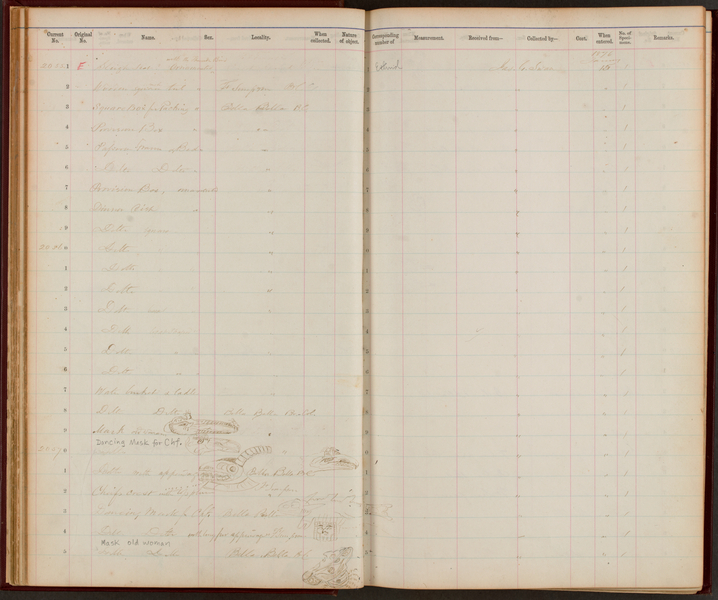Mask, Helmet Item Number: E20569-0 from the National Museum of Natural History











Notes
FROM 19TH OR EARLY 20TH CENTURY EXHIBIT LABEL WITH CARD: "HEAD-DRESS. - CARVED FROM A SOLID BLOCK OF WOOD. BEHIND IS A HEMISPHERICAL CAP FOR THE HEAD OF WEARER, AND PROJECTING IN FRONT OF THIS IS A LARGE AND ELABORATELY CARVED AND PAINTED BIRD'S HEAD, HOLDING IN ITS BEAK THE SMALL FIGURE OF A MAN, TOES DOWNWARD, WITH HEAD PROJECTING BEYOND BEAK AND LOOKING AHEAD. ON TOP OF BIRD'S HEAD ARE OTHER SMALL HUMAN FACES. THE COLORS ARE BROWN, BLACK, RED, AND WHITE. THE PUPILS OF EYES OF BIRD ARE OF POLISHED IRON. WORN IN DANCES BY INDIANS OF BELLA BELLA. LENGTH, 20 INS. HEIGHT, 9 INS. WIDTH, 9 INS. DIAM. OF CAP, 7 INS. " From card: "Loan: Museo Nacional de Antropologia, May 18, 1964." Loan returned 2012.Catalog card gives 5260 as accession number, but 4686 (also from Swan, in 1876) is more likely, as that accession contains objects from British Columbia.Ian Reid (Heiltsuk), Clyde Tallio (Nuxalk) and Evelyn Windsor (Heiltsuk elder) of the delegation from Bella Bella, Bella Coola and Rivers Inlet communities of British Columbia made the following comments during the Recovering Voices Community Research Visit May 20th -24th, 2013. Consensus is that it looks like a raven. The holes were probably used in order to attach hair, likely human. A mask was used by a dancer at a potlatch then immediately put away, out of sight. This mask is one piece of wood, which looks to be alder. It contains classic Nuxalk or Kimsquit characteristics in the stylized carving of the face and ear. This mask was likely used at initiation ceremonies in which the person would receive their ancestor name.
Item History
- Made in British Columbia, Canada
- Collected by James G. Swan in British Columbia, Canada
- Received during 1876
What
- Name
- Mask, Helmet
- Identification Number
- E20569-0
- Type of Item
- headdress
Who
- Culture
- Bella Bella (Heiltsuk)
- Field Collector
- James G. Swan
Where
- Holding Institution
- National Museum of Natural History
- Made in
- British Columbia, Canada
- Collected in
- British Columbia, Canada
When
- Acquisition Date
- during 1876
Other
- Accession Number
- 004686